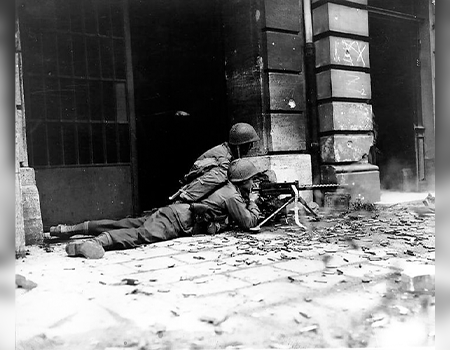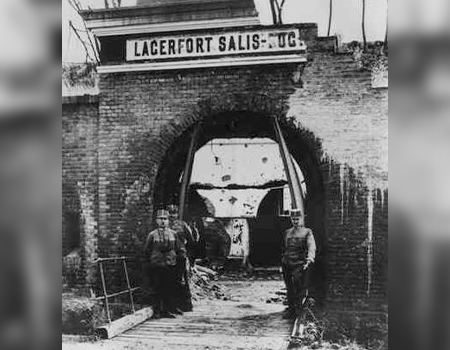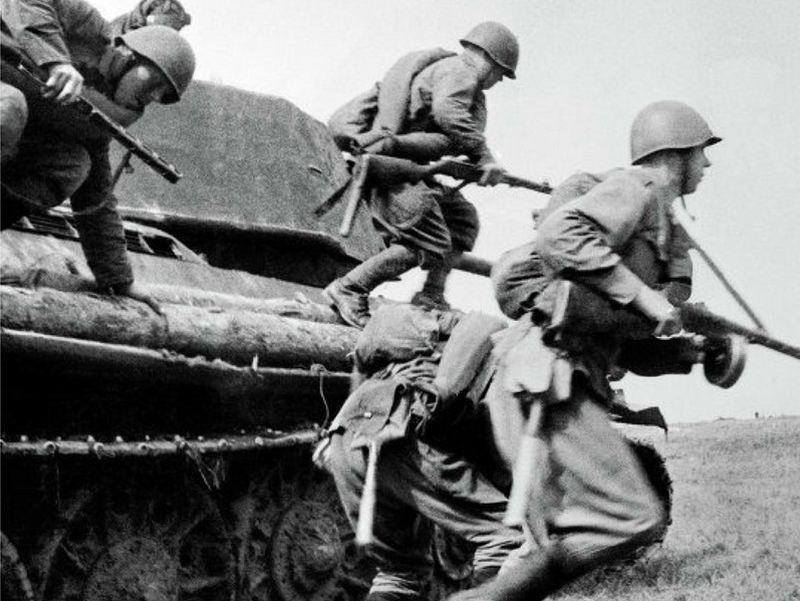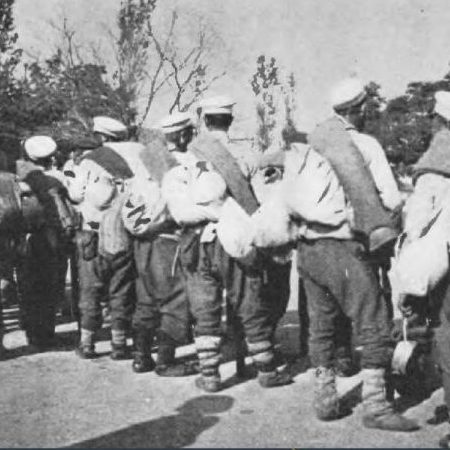
I would like to transport the reader to the first days of October 1918. The Great War, the First World War, is nearing completion. But, unfortunately for those who are on the battlefield, there is still more than a month left for the signing of the armistice. We are in a very specific sector of the western front. Non other than at a spot in east of France, between Reims and Verdun. I speak of an extensive forest that crosses this land from north to south, called Argonne. In a matter of hours, that soil will witness a real hell that, for those who ‘taste’ history, it’s hard to imagine what their protagonists experienced.
Argonne, if we place it on one of the maps that the High Command of the Allied armies manages, it is another point where the Meuse-Argonne offensive has just been unleashed, inside a greater campaign that seeks to press and destroy the defensive German lines. In this huge campaign, started in August 1918, which will go down in History as “The Hundred Days Offensive”, intervene armies from France, the United Kingdom (in addition to other Commonwealth countries) and the United States (with forces from other allied nations). The campaign has been conceived and set in motion to force Germany to total surrender. To do this, taking the well-known city of Verdun as its apex, the allied armies will begin to press in a coordinated way north and south of that town … But also its immediate surroundings … The North American troops will be in charge of this in the recently inaugurated month of October 1918.
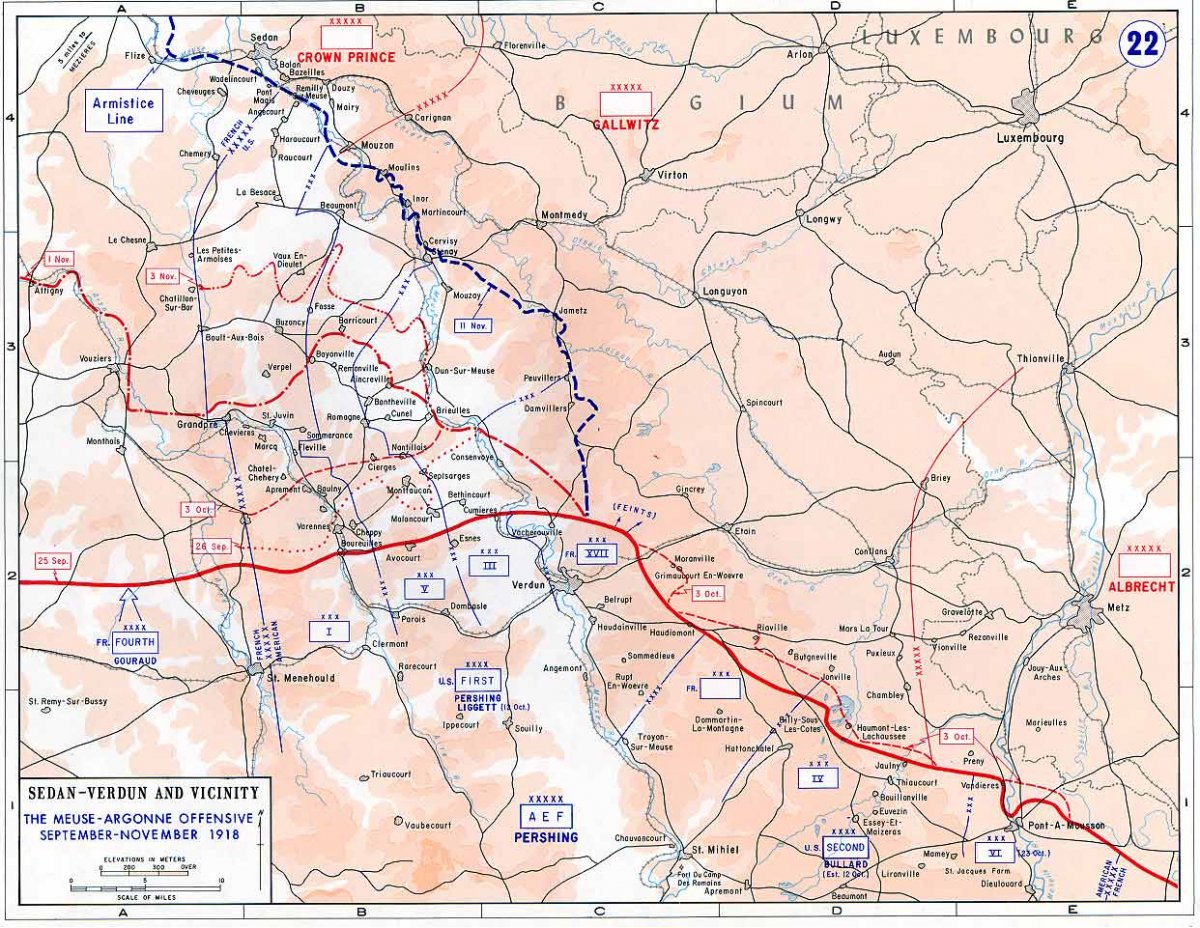
Map of the general situation of the Great War’s final stretch.
WHAT IS HIDDEN IN ARGONNE?
In the forest of Argonne, one of the densest around Verdun, the Germans await the inevitable. From the early stages of the war the Germans have occupied it, and those who will dare to enter the forest will face an almost certain death. The interior of the forest is fraught with interconnected trenches. A network of defensive front-line positions, listening posts and parapets that, as an advance, Germans use to detect possible enemy incursions. Behind this first line, along several hundred meters, dense frameworks of barbed wire, even some lying under the river flow and the streams that cross the vegetation, form a sea of steel-spikes almost insurmountable.
Behind these first obstacles, a second line of more solid trenches draws a barrier between the trees that no one in their right mind would dare to assault. Protected by fortified posts where machine guns, artillery pieces and mortars have been placed, the Germans still maintain firm confidence in their defensive system, because so far, they have managed to repel all the attacks launched by their adversaries. Inside these positions, well camouflaged between the vegetation and the wooded surroundings, the soldiers of the Kaiser Wilhelm II whisper to each other. One of the many soldiers claims to have heard from the officers that an imminent American attack looms over them. Will that rumor be true?
WHO GOT INTO THAT DEATH TRAP?
The general in command of the troops that are about to enter Argonne, few days ago made clear a categorical order in the following terms – it was said that it came close to a suicide order:
“…One of the Germans’ favourite tricks is to sow confusion by shouting withdrawal orders. If, in the middle of the fight, any order of that kind is heard, troop and officers will make sure that it is issued by the enemy. Whoever gives that order is a traitor and the duty of any officer or man faithful to his country […] is to shoot the transgressor on sight”.
As if the above was not enough, General Alexander, a brave and courageous man, coined the following words: “We are not going to step back except to move forward!“. Alexander commanded the 77th Infantry Division, the absolute protagonist of the feat that, not for one moment, was about to be recorded in the history books..

General Robert Alexander.
On 1st October, Major (commander) Charles White Whittlesey, a 34-year-old native of Wisconsin, receives the advance order, which must be executed through the left end of the Argonne forest. Commander Whittlesey, who is part of the aforementioned 77th Infantry Division, marches with his brothers in arms: around 550 soldiers (troops and officers). One of his main tasks is to take the road Binarville – Charleveaux, where a mill will serve as a reference to indicate that they are marching in the right direction. Once the first mission is completed, he should go deep into the forest, but not before capturing and securing the road and even a railway line that runs in parallel. If he succeeds, it will cause the Germans a serious headache, as one of its main supply routes will be cut in half.

Commander Charles White Whittlesey.
Although Whittlesey is the commander of the 1st Battalion of the 308th Infantry, he will soon face the situation of running a hodgepodge of Companies: the A, B, C, E, G and H of the 308th Infantry Regiment, the Company K of the 307th Infantry Regiment and Company C of the 306th Machine Gun Battalion (some sources also add Company D of this last battalion). All these companies belong to the 154th Brigade of the 77th Infantry Division. Still some hours away until Whittlesey will face a destiny he would have never imagined, now that, more than ever, the end of the war and the victory over Germany are presumed within reach.
THE ATTACK BEGINS.
On the same day, 1st October, Whittlesey and his battalion are already underway to fulfill their mission. They do not take long to engage in some scuffles with the Germans. Skirmishes and exchange of gunfire that do not stop the progress of the unit led by Whittlesey, but the task is not as simple as presumed in the first place. After five o’clock in the afternoon, the fighting ceases and among men winds the order to take cover to spend the night outdoors.
The next day, on 2nd October, the fate of Whittlesey and his men is about to suffer an unforeseen setback that, during the first hours of the day, seems inconceivable. The progress of the Americans toward their goals is not easy. The combat in the outskirts of the forest, and later inside, starts to take its toll on his unit. It seems that the Germans do not contemplate the idea of withdrawal by a long chalk. Both their defensive system located in Argonne and their trajectory during long years of struggle in the Great War, manage to keep at bay the soldiers arrived on French soil from America. Many of them hardly have enough experience to face with confidence an experienced adversary who is aware to be in a life-or-death situation. Inexperience that is paid with blood. Blood that permeates the land where Whittlesey himself stands.

Illustration that shows the hell of Argonne (credits to its author)..
Behind his inseparable rounded crystals’ glasses, the officer’s look, looking calm despite the din of the fighting, perches on the bodies of those men who have just perished under the Germans. Covered behind a fold of the land, the commander analyzes the situation while the bullets whistle over his head and the explosions of the Germanic shells crush everything around them. The medics can hardly do their job. Too many wounded and dying to attend at the same time. Even the stretcher-bearers, exhausted and showing absolute courage, slog their guts out to evacuate from the first line of fire those who show the slightest chance to save their life in the rear.
Whittlesey does not panic. Man of laws in civil life, intelligent, constant, selfless and fighter, he is an officer of humble origins who knows what it costs to achieve something in life. Stuck in that place waiting for the death gale to get worse, he will never achieve the assigned objectives, so he decides to continue the advance. Under his leadership, with renewed vigor, the attack of the Americans through the forest is met with certain success. At nightfall, exhausted and terribly thirsty, receives encouraging news. Some of his subordinates have found a chink in the enemy’s defenses that can lead them to one of the flanks of Hill 198, one of the relevant targets indicated on his map.
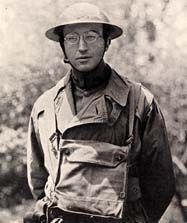
Commander Whittlesey.
Unfortunately for Whittlesey’s battalion, and for the rest of the 154th Brigade, devastating news comes to their ears. Their French comrades, in addition to other American units that were supposed to cover both flanks of Whittlesey and his men’s advance during that day, have not progressed in enemy territory at the same pace as they have. The Germans have counterattacked in their respective sectors and have slowed and even repelled the Allied attack. But the worst of all is what crosses his mind at this very moment.
During the final hours of the day he managed to reach the top of Hill 198 and there, like an island in the middle of the ocean, he is surrounded, not by water, but by hundreds of Germans willing to hunt his men and himself relentlessly .
After the great achievement of the assault on Hill 198, everyone receives the order to dig foxholes and hide as best they can to spend the tense night ahead. Whittlesey is aware of what is happening. They are isolated. Surrounded by an enemy that outnumbers them and have more supplies. And, something that could be fatal, there is barely any way to communicate with the nearest units. Men who serve as links and carrier pigeons are the only options available to reveal their critical situation.
The forest is shrouded in darkness. Numerous parapets and German frontline trenches, the last ones forcibly evicted by the North Americans, now serve as an improvised resting place. But, nothing could be further from the truth … Allowing Whittlesey and his people to take a break does not fit into the enemy’s plans.
LONG NIGHT ON HILL 198.
The air rocks the trees’ branches. Its whistling is intimidating; sinister noises for the men trapped in the middle of the vast stands of trees. After a progress report, Whittlesey realizes that he is the highest ranking living officer of that encirclement. Therefore, from that moment, he is not longer the commander of the 1st Battalion of the 308th Infantry Regiment, but the commanding officer of the entire contingent there trapped. Now he coordinates all the companies, eight according to some sources, nine according to others … Under the heavy cloak of darkness, he does not know exactly how many men are in the contingent he leads. Five hundred men? Four hundred after the first forty-eight hours of fighting inside that infernal forest? … Who knows!

American soldiers somewhere not far from the front.
Reality is implacable. Neither the French nor their American comrades are where they were supposed to be. The flanks have been left exposed and the critical situation forces him to think quickly. Under the unbearable pressure, deep in thought, he busts through a plan to guarantee the survival of his men, at least of most of them. There, on top of the hill, he arranges the different companies in such a way that, with the greatest discretion before the enemy’s eyes, arranges a defensive perimeter where the less punished companies are responsible to defend the extremes. On the other hand, the front of the perimeter, which faces the Germans, remains covered only by a single company, while the rear will be monitored by groups of riflemen and machine gunners who will have support from inside the siege when the moment of the inevitable German counterattack arrives.
Covered by the darkness, with a look that reflects mettle and concentration, Whittlesey needs to know the state of his men along the perimeter at all costs, but it is also crucial to contact other units out of the encirclement. Those moments witness scenes of true value. It is the turn of the messengers (or “runners”). A handful of men who, knowing the predictable end that awaits them, in some cases volunteer and in others receive the order, for a job classified as suicide. They must travel through the forest alone, under the close surveillance of the Germans, to deliver or receive vital information.
You can imagine what some of them would have felt in those moments. Sensations that oscillate between commitment and loyalty to their brothers in arms, others would do it with blind faith for the fulfillment of duty and the resignation to do what is necessary. Whatever the case, many of them, in the middle of fast races through the forest, rifle in hand and with the lungs about to burst, perished under the well-aimed enemies’ fire. A favourable night for hunting for the German snipers. A favourable night to find a death worthy of the highest admiration in case of being one of those soldiers who, in a vain attempt to slip out of the encirclement, made the maximum sacrifice in pursuit of a much needed rescue for their comrades.
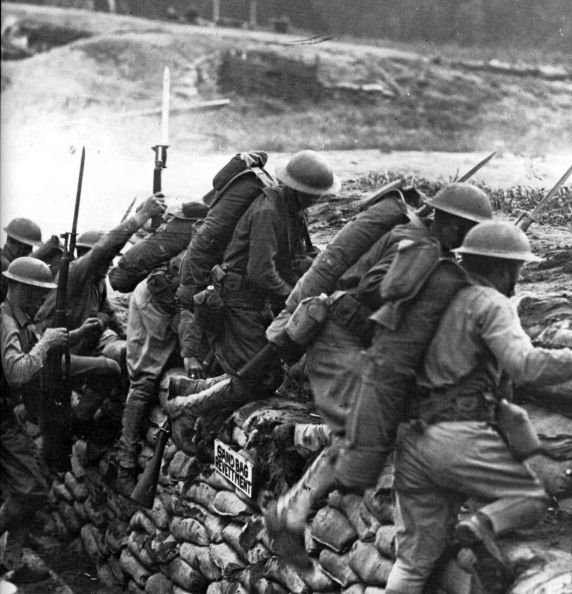
North American soldiers abandon a trench (image of a training exercise).
Meanwhile, the night unfolds tensely. Everybody has their nerves on edge. Several groups of Germans infiltrate the defensive perimeter established by the Americans to cut off the communication routes and cause as many casualties as possible. But why do the Kaiser’s soldiers insist on doing so? Simple answer. Some German officers believe that, at the same time, they are cornered by the Allies, so they have decided to make their way through the forest at all costs. Or at least, they will try to open a corridor through which the rest of their comrades, located in the rear, can evacuate their positions. Absolute confusion.
3RD OCTOBER 1918.
Throughout the morning, the Germans launch several attacks from all ends of the American defensive perimeter. The latter, outnumbered and unable to have a secure line through which to receive valuable supplies (food and ammunition), are ready to resist everything that the Germans are about to unleash on them.
Some are stuck to the ground looking for protection. Others, the Germans, advance cautiously through the vegetation. Once the contact between the two forces takes place, the first shots are immediately heard. The contenders’ gunfire crackles incessantly. Its horrifying echo can be heard across the length and breadth of the forest. When the distance is shortened, the hand grenades fly dangerously from one position to another. The terrible explosions leave a moaning trail behind, capable of harrowing up the soul of anyone with sense. Voices crying for help are mixed together with the fight’s ecstasy screams. Orders and oaths in both languages go with the bursts of machine guns that take lives with amazing ease. The automatic weapons are devastating. To make things worse, when men are a few meters from each other, the brutal hand-to-hand combat begins. We are in the First World War, where this kind of fight becomes savage. The bayonets placed in the rifles reflect with dreadful hues the daylight. Same as the trench knives, combat knives, guns, daggers and any improvised tool that can be used as an instrument of instant death over short distances.

Infantrymen of the US Army handle a machine gun.
Germans and Americans are locked in an unparalleled brawl. There are those who do not hesitate to skewer their adversary’s body with the bayonet after making an energetic homicidal movement capable of tearing the guts and the soul of those who cross their path. Men who receive the fatal blow, utter incomprehensible grunts while clinging to the weapon held by their adversary. One and all fall on their knees before the astonished gaze of those who have just snatched their lives. There are those who no longer feel remorse, because they know that it’s time to kill or die. Blood flows from the bodies pierced by the bayonets, still trembling. The viscous scarlet liquid runs down the rifles and ends on the hands of those who have had the courage to break through another soldier. A soldier who, like them, has been engulfed in the absurdity of a war that has ravaged Europe, and also its youth and civilian population.
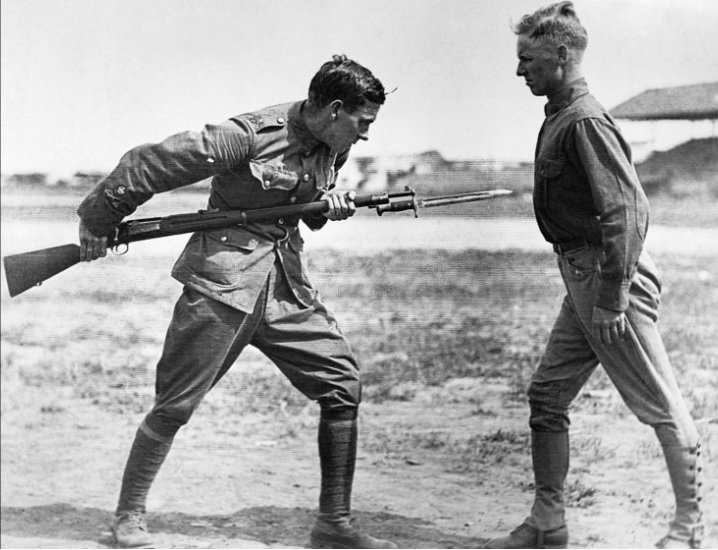
Recruit and instructor during a bayonet exercise.
At some point, Whittlesey realizes that one of his officers has launched a suicide attack to make his way out of the encirclement. In that precise moment he almost freaks out , because that attack has caused many losses for the North Americans … And, the worst thing of all, all the sacrifice has served no purpose. In order to avoid greater evils, he orders the survivors to retreat towards the interior of the defensive perimeter, where they will have greater options of survival. In the midst of that deafening chaos, the German artillery comes into play with excessive violence.
How will the 77th Infantry Division come out of this? What is the weapon that will lead the battle in the Argonne forest? We are waiting for you in the next installment of this post about the First World War.
An article by Denix guest blogger: Daniel Ortega del Pozooriginal post published on DENIX website on 12/07/2018



